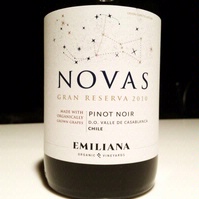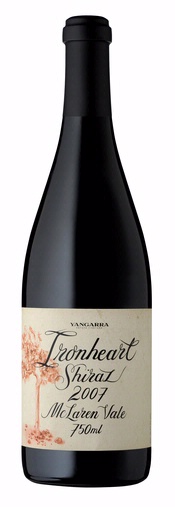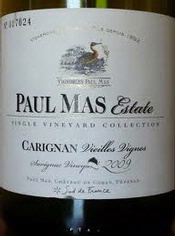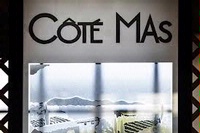|
|
 |
|
October 23, 2013
Over the course of any given week, I sample in the neighborhood of 100 wines
on average. There are good weeks and bad weeks, and everything in between. My
quest, of course, is to identify a wine or two I can recommend. Not every wine,
not even every good wine, passes muster.
I need to be moved, to have some
emotional connection to what’s in the glass, and I can’t always predict what
that will be. So I’m looking back on my tasting notes from last week and there
are two wines that I can’t get out of my head, both from Chile.
 The South American country boasts a vibrant wine industry
that has established an impressive record for quality and value over the past
two decades, attributes that make Chilean wines extremely popular in the United
States. Chile does a particularly good job with wines at the lower rungs of the
price ladder, generally with a fairly generic appellation of origin designation
such as “Central Valley.” The South American country boasts a vibrant wine industry
that has established an impressive record for quality and value over the past
two decades, attributes that make Chilean wines extremely popular in the United
States. Chile does a particularly good job with wines at the lower rungs of the
price ladder, generally with a fairly generic appellation of origin designation
such as “Central Valley.”
But Chile is a vast country with cool coastal
valleys that produce outstanding Chardonnay and Sauvignon Blanc and warmer
inland valleys that are ideal for Cabernet Sauvignon, Merlot and the uniquely
Chilean Carmenere, a wine that traces its roots to Bordeaux although the
carmenere grape is no longer planted in that part of the world.
These
diverse terroirs are the untold story of Chilean wine.
What intrigued me
most last week was the 2011 Marques de Casa Concha Chardonnay from Chile’s
Limari Valley, located about 250 miles north of Santiago near the Pacific Ocean.
The region has been under vine for more than two centuries, but only recently
have wineries invested heavily in new vineyards and technology.
The soils
of Limari are limestone and clay, which when combined with the cooler climate
yield wines of elegance and finesse. The Marques de Casa Concha Chardonnay,
which carries an average retail price of $18 at WineSearcher.com, struck me as
an outstanding example of the stylistic potential of the wines from Limari. It
is crisp and firmly structured while exhibiting notes of spice and lemon crème,
with a hint of brioche. And the winemaker, Marcelo Papa, touched on another
note.
“I love the minerality I find in this wine,” he told
me.
Papa is the chief winemaker for Marques de Casa Concha and also head
of production for the more generic wines of Casillero del Diablo, both of which
are owned by Concha y Toro, Chile’s largest wine company. The Marques de Casa
Concha line focuses exclusively on the diversity of Chilean soil and climate to
make wines that reflect authenticity of place.
Whether you are a fan of
Chardonnay or not, this vintage of Marques de Casa Concha is a stunner, even
moreso because of the price. The suggested retail is $23, but I found it on
WineSearcher for as little as $16, with the average price being $18. I would not
hesitate to serve it in company with Chardonnay from California or France
costing twice as much.
 It
was just that sort of quality to price ratio that grabbed me when I tasted the
2012 Novas Gran Reserva Pinot Noir later in the week. This is an organic wine
made by Spanish winemaker Noelia Orts from grapes harvested in the cool
Casablanca Valley near the Chilean port of Valparaiso. Pinot Noir plantings in
Chile are in their infancy and there is a large body of work to make meaningful
comparisons, but the Novas Gran Reserva demonstrates the potential when the
grape is planted in the right place. It
was just that sort of quality to price ratio that grabbed me when I tasted the
2012 Novas Gran Reserva Pinot Noir later in the week. This is an organic wine
made by Spanish winemaker Noelia Orts from grapes harvested in the cool
Casablanca Valley near the Chilean port of Valparaiso. Pinot Noir plantings in
Chile are in their infancy and there is a large body of work to make meaningful
comparisons, but the Novas Gran Reserva demonstrates the potential when the
grape is planted in the right place.
Orts, who also makes the biodynamic
wines of Emiliana, previously worked at Miguel Torres and Marques de Grinon in
Spain before moving to Chile.
“I have a strong belief that Casablanca is
the place for Pinot Noir in Chile,” she told me.
The 2012 Novas Gran Reserva
Pinot Noir is beautifully balanced, with juicy red-fruit aromas and a firm,
crisp structure. Best of all: the price. I found it on WineSearcher for $16.
Anyone familiar with the cost of Burgundy or palatable Pinot from Oregon or
California must realize this is a remarkable price for a quality Pinot
Noir.
With Thanksgiving looming and thirsty friends and family to
entertain, this is one wine that should be on every wine enthusiast’s shopping
list.
Follow Robert on Twitter at @wineguru.
Posted by Robert Whitley at 8:17 AM
|
|
October 18, 2013
Once upon a time in the land of Oz there was a plan to establish a beachhead for
Australian wine in California, from whence the Aussies would take the American
wine market, the largest market for wine in the world, by storm. Funded in part
by the Australian government, the plan seemed to work.
Aussie Shiraz was
going to be the next big thing in wine, and for a time it was. Americans,
particularly Californians, were drawn to the ripe, plush fruit aromas and
textures of these big, bold red wines from Australia. Even better, the exchange
rate favored the American consumer and thus high-quality red wine from Australia
was relatively cheap.
 Large
Australian wine companies such as Penfolds, Wolf Blass, Rosemount Estate,
Lindemans, Hardys, Peter Lehmann and Jacob’s Creek aggressively expanded their
reach into the United States and threatened to seize a sizable chunk of the
market share, primarily taking it away from the dominant California
wineries. Large
Australian wine companies such as Penfolds, Wolf Blass, Rosemount Estate,
Lindemans, Hardys, Peter Lehmann and Jacob’s Creek aggressively expanded their
reach into the United States and threatened to seize a sizable chunk of the
market share, primarily taking it away from the dominant California
wineries.
Then a funny thing happened: The bottom fell out. First, the
Australian wine industry began to cannibalize itself. Mergers and acquisitions
blurred the lines between long-established brands that once competed fiercely to
establish identity, only to find in the long run that yesterday’s competitor was
today’s stablemate.
Then quality, at least at the bigger Australian wine
companies, took a hit as executives became increasingly concerned with return on
investment. This was followed by a grape glut, which put downward pressure on
prices. And, finally, California wineries fought back, generating new tiers of
existing brands that could compete in the arena of price and quality. That the
exchange rate on the dollar swung in favor of the Aussies only exacerbated the
problem for the Australian wine producers trying to maintain their hard-earned
share of the U.S. market.
In the end, the grand plan fizzled and the
Australian wine experiment in the United States appeared to be on course for a
giant boomerang. In one sign of abject failure, a large Australian wine company
recently destroyed millions of dollars in back inventory it had been unable to
sell. In short, Aussie wine in the U.S. market was a train wreck.
So it
was with a bit of skepticism, and also a dash of curiosity, that I agreed to sit
down recently with Australian winemaker Peter Fraser and taste his wines from
Yangarra Estate Vineyard, a 400-plus-acre spread in the McLaren Vale region of
South Australia. Fraser, who has an impressive track record at multiple wineries
in South Australia, has been at the helm of Yangarra Estate since the property
was purchased by the late Jess Jackson in 2000.
Jackson, an American,
made his mark in wine with the popular Kendall-Jackson brand, but he was also a
global visionary who purchased numerous wineries in Italy and France, and
eventually Yangarra in Australia. Jackson probably never got his due for efforts
to improve the breed, but in his later years he worked steadfastly to focus his
wineries on better vineyard sources and state-of-the-art
winemaking.
Yangarra, for example, began farming its vineyards
organically and biodynamically in 2008, and was certified biodynamic in
2012.
“We were looking for greater purity of expression from the
vineyards,” Fraser explained. “And we wanted to enhance the minerality and
elegance that is inherent in many of our wines.”
 There
is no easy transition to biodynamic farming, for it requires biodiversity that
involves the presence of farm animals, composting, and strict attention to the
cycles of the moon. Few wineries in Australia have gone to the trouble, though
Fraser cites the iconic Cullen winery of Margaret River in Western Australia as
a good example. There
is no easy transition to biodynamic farming, for it requires biodiversity that
involves the presence of farm animals, composting, and strict attention to the
cycles of the moon. Few wineries in Australia have gone to the trouble, though
Fraser cites the iconic Cullen winery of Margaret River in Western Australia as
a good example.
In Fraser’s telling, the expressions of the various soils
throughout the vast Yangarra estate are what make the wines compelling and
unique. Of the 400-plus acres, 250 are planted to grape varieties typically
found in the southern Rhone Valley of France. The soils range from huge
ironstone deposits, which impart a distinct minerality to the estate’s Shiraz,
to alluvial and sandy soils where bush-vine (with no trellis system) Grenache is
planted.
Then there is the human element. As the winemaker, Fraser
dissents from the doctrine of ripeness practiced by many of his Aussie brethren.
There is no big blast of alcohol from the Yangarra wines, a departure from the
norm of Australian Shiraz. Fraser works studiously in the vineyards and the
cellar to control the alcohol level in the Yangarra wines.
When he makes
the decision to harvest “I am looking for texture and elegance as much as
flavor” Fraser explained. The Yangarra wines are impeccably balanced, including
a luscious Viognier, which is typically made in an ultra-ripe style throughout
the New World. The Yangarra Viognier could easily pass for French in a blind
tasting.
For the money, the Yangarra wines deliver the sort of
price/quality ratio that helped create demand for Australian wines in the first
place. The Viognier and a delicious Roussanne each retail for $25, and the
flagship Old Vine Grenache is $32. There is but one truly budget-busting wine in
the Yangarra portfolio and that is the Ironheart Shiraz that retails for $100, a
price that reflects both its unique characteristics and its limited
availability. A superb GSM blend (Grenache, Syrah and Mourvedre) reminiscent of
Chateauneuf-du-Pape is a palatable $28.
As I tasted each wine in the
lineup, I was impressed by the brilliance versus the cost and it occurred to me
Yangarra, and wineries of its ilk, may well be the future of Australian wine in
the U.S. market. It would be a very bright future, indeed.
Follow
Robert on Twitter at @wineguru.
Posted by Robert Whitley at 11:21 AM
|
|
October 7, 2013
Selecting the winery of the year from those
entered in the 2013 Sommelier Challenge in September would be a snap if it
simply came down to the winery with the most medals. By that reckoning, the Napa
Valley winery V. Sattui would emerge the champ nearly every year. At the very
least, it would be a contender.
And so it was this year, with V. Sattui taking
23 medals overall from 31 wines entered. But as the Director of the Sommelier
Challenge, it is my task to scrutinize the evaluations of the judges (16
certified sommeliers from around the nation) and look beyond the numbers for a
performance that stands out above and beyond the rest.
 With
that in mind, I took a long, hard look at the Champagne house Moet & Chandon
of Epernay, France, which entered five wines in Sommelier Challenge V. One of
the five, the 1993 Grand Vintage Collection Brut ($140), was a deserving winner
in the final vote for Wine of the Year. The other four Moet wines were awarded
gold medals. All of the Moet entries were impeccable in an impressive
performance. Still, there was another winery, also from
France, that caught my eye. Chateau Paul Mas, a wing of Domaines Paul Mas,
entered eight wines and medaled with seven. Three of those seven were awarded
platinum medals and competed in the championship rounds where best of show and
winery of the year are determined. The Chateau Paul Mas entries ranged in price
from $8.99 to $27 suggested retail, and as I tasted each I noted with great
satisfaction that they were beautifully balanced, suave and sophisticated, and
most of all delicious.
The wines of Chateau Paul Mas went up against
an array of superb wines from many of the wine world’s finest wine addresses and
proved themselves worthy. For this reason, I have chosen Chateau Paul Mas of
Pezenas, in the Languedoc region of southern France, to receive the Director’s
Award as the 2013 Sommelier Challenge Winery of the Year.
 This level of
excellence from the hinterlands of the French wine industry, a region once known
only for its ocean of generic “bulk” wine, would have been unthinkable as
recently as 20 years ago. The Languedoc, which covers the Mediterranean coast
from Montpelier to the Pyrenees and the Spanish border, has undergone a
renaissance in recent years, led in part by visionary enterprises such as
Domaines Paul Mas and Gerard Bertrand, as well as boutique producers such as
Domaine Mas Jullien. The potential was always there in a land
dotted with well-kept 50-to-75-year-old family owned vineyards planted to syrah,
carignan, mourvedre and grenache. But the area was so poor in post -World War II
France that few families had the money or the manpower to tend the vines, then
make and market their wines.
So the fate of those outstanding old-vine
vineyards was up to the many vintner cooperatives that sprang up after the war,
with the result that prime wine grapes were blended with lesser grapes from
over-cropped vineyards to make cheap wine. It is only over the past 10 to 15
years that entrepreneurs with a vision of quality have been able to rescue the
Languedoc from the wine wilderness.
 Chateau
Paul Mas produces wines under several affiliated labels, including Cote Mas and
Paul Mas Estate. Its platinum award-winners were the 2011 Chateau Paul Mas Clos
de Savignac, Gres de Montpelier ($27), 2012 Chateau Paul Mas Belluguette,
Coteaux du Languedoc ($20) and 2011 Paul Mas Estate Carignan, Vielles Vignes,
Savignac Vineyard, Pays d’Herault IGP ($14). The two from Chateau Paul Mas are red and
white Rhone-style blends with varying levels of syrah, grenache and mourvedre,
while the simply stunning Paul Mas Estate Carignan is a single-vineyard wine
made from old vines (hence Vielles Vignes). The 2012 Paul Mas Estate Picpoul de
Pinet IGP ($14), a crisp white wine made from vineyards within spitting distance
of the sea, also was awarded silver.
Cote Mas was awarded a gold for its
non-vintage Cremant de Limoux AOP Rose ($17) and a silver for a white
Rhone-style blend, 2012 Blanc Mediterranee, Pays d’Oc IGP ($8.99). Yet another
Paul Mas label, 2012 La Forge Estate Cabernet Sauvignon, Pays d’Oc IGP ($12) won
a silver medal.
These wines are not only exceptional by
anyome’s standard, they’re also attractively priced. It is a beautiful
thing.
Follow Robert on Twitter at
@wineguru.
Posted by Robert Whitley at 6:40 PM
|
|
October 2, 2013
The fifth annual Sommelier Challenge wine competition, staged the last
weekend of September in San Diego, had a decidedly international flair. A glance
at the top awards confirms as much.
Six different countries – the United
States, France, Italy, Canada, Portugal and Greece – were represented among the
Best of Show winners, and France claimed the biggest prize of them all in the
final vote for Wine of the Year, which went to Moet & Chandon’s 1993 Grand
Vintage Collection Brut Champagne ($140).
The Sommelier Challenge brought
together 16 certified sommeliers from around the nation to evaluate a record
total of 898 wines at a “blind” tasting in which the identity of the producer
and the name of the wine was concealed until after awards had been assigned. The
somms were divided into panels and each panel tasted approximately 130 wines,
sending its favorites on to the championship round where best of class and best
of show awards were determined.
The 1993 Moet, as Wine of the Year, also
claimed title to the Best of Show sparkling wine award, prevailing in the
championships over Italy’s 1996 Ferrari Perle, Trento DOC ($42) and Domaine
Carneros Cuvee de la Pompadour Brut Rose ($36) from the Napa Valley side of the
Carneros district. All three sparkling wines were exquisite, but the Moet was
simply stunning, and remarkably fresh despite its 20 years of age.
In the
finals Moet faced another 20-year-old, the Taylor Fladgate 20-Year-Old Aged
Tawny ($54.99) from Portugal’s Douro Valley, winner of Best of Show fortified
wine, but neither the Port nor any of the other six finalists were a match for
the dramatic impact of the Champagne.
There were two ties in the
best-of-show voting prior to the final vote for wine of the year. Italy’s
Castello di Gabbiano 2009 Chianti Classico Riserva ($22) and the Napa Valley’s
Black Stallion 2010 Cabernet Sauvignon ($28) finished in a dead-heat in the vote
for Best of Show red wine, and Canada’s 2008 Inniskillin Riesling Icewine,
Niagara Peninsula ($80) and Virginia’s Barboursville 2008 Malvaxia Reserve
Passito ($31.99) tied in the Best of Show dessert wine category.
Best of
Show white wine went to the 2012 Dr. Konstantin Frank Riesling Reserve ($25)
from New York’s Finger Lakes region and Best of Show rose was taken by the 2012
Falkner Winery Rosato, Temecula Valley ($15.99). The Greek Liqueur Pilavas
Tentura Liqueur ($24) won the Best of Show spirits award, but was ineligible for
the wine-of-the-year vote.
Complete
results.
Posted by Robert Whitley at 9:57 AM
|
|
 |
|